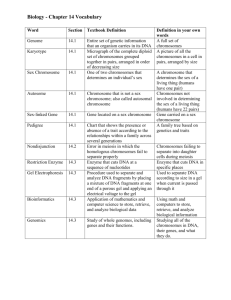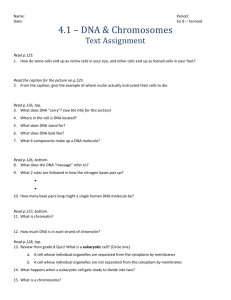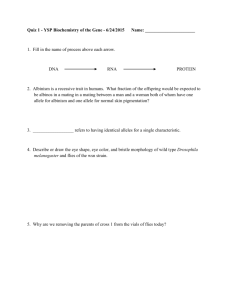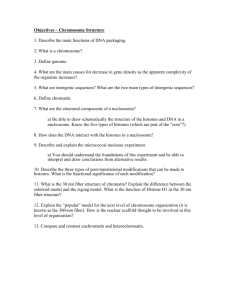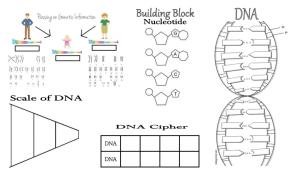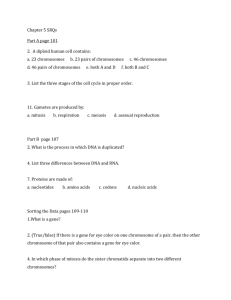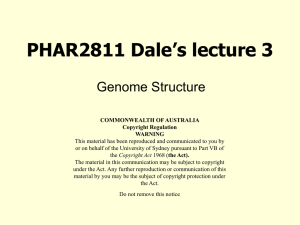Lecture 31: Anaerobic Metabolism & Introduction to Genetics
advertisement
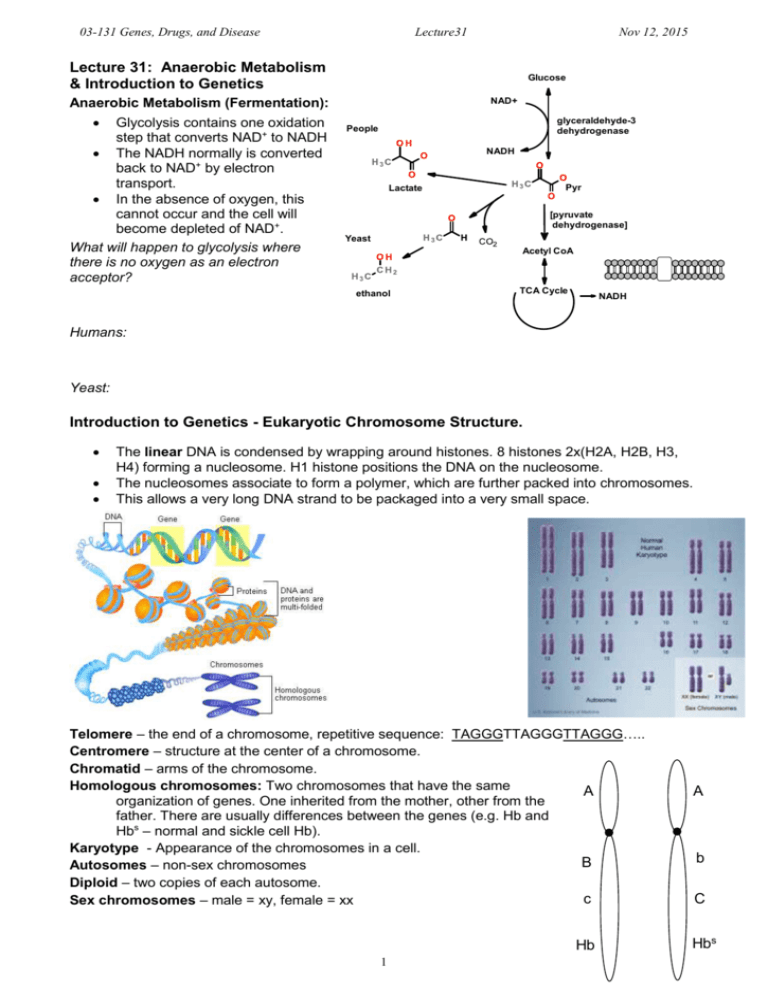
03-131 Genes, Drugs, and Disease Lecture31 Nov 12, 2015 Lecture 31: Anaerobic Metabolism & Introduction to Genetics Anaerobic Metabolism (Fermentation): Glycolysis contains one oxidation step that converts NAD+ to NADH The NADH normally is converted back to NAD+ by electron transport. In the absence of oxygen, this cannot occur and the cell will become depleted of NAD+. What will happen to glycolysis where there is no oxygen as an electron acceptor? Glucose NAD+ glyceraldehyde-3 dehydrogenase People NADH Pyr Lactate [pyruvate dehydrogenase] Yeast Acetyl CoA ethanol TCA Cycle NADH Humans: Yeast: Introduction to Genetics - Eukaryotic Chromosome Structure. The linear DNA is condensed by wrapping around histones. 8 histones 2x(H2A, H2B, H3, H4) forming a nucleosome. H1 histone positions the DNA on the nucleosome. The nucleosomes associate to form a polymer, which are further packed into chromosomes. This allows a very long DNA strand to be packaged into a very small space. Telomere – the end of a chromosome, repetitive sequence: TAGGGTTAGGGTTAGGG….. Centromere – structure at the center of a chromosome. Chromatid – arms of the chromosome. Homologous chromosomes: Two chromosomes that have the same A organization of genes. One inherited from the mother, other from the father. There are usually differences between the genes (e.g. Hb and Hbs – normal and sickle cell Hb). Karyotype - Appearance of the chromosomes in a cell. B Autosomes – non-sex chromosomes Diploid – two copies of each autosome. c Sex chromosomes – male = xy, female = xx Hb 1 A b C Hbs 03-131 Genes, Drugs, and Disease Lecture31 Nov 12, 2015 Replication of Linear Chromosomes – What to do at the ends? The lower strand can be replicated to its end as part of the leading strand synthesis. The upper strand cannot because it cannot be primed. Chromosomes would shorten after each replication. Polδ = Pol III Polα = Pol I Gyrase = Toposiomerase Telomerase – A reverse transcriptase with its own template. Telomerase 3' 5' 3' 5' 5' 3' 5' 5' 3' 5' 5' 5' 3' 5' 5' 3' 5' 5' 3' 5' 3' 5' 3' TAGGG TAGGG TAGGG ATCCCATCCC 3' TAGGG TAGGG TAGGG 5' 3' 5' 3' TAGGG TAGGG ATCCCATCCC ATCCCATCCC TAGGG TAGGG TAGGG TAGGG ATCCCATCCC TAGGG TAGGG TAGGG TAGGG ATCCCATCCC TAGGG TAGGG TAGGG TAGGG TAGGG 5' 3' 3' ATCCCATCCC TAGGG TAGGG TAGGG TAGGG TAGGG ATCCCATCCC 3' Primase TAGGG TAGGG TAGGG TAGGG TAGGG ATCCCATCCC DNA polymerase TAGGG TAGGG TAGGG TAGGG TAGGG ATCCCATCCC TAGGG TAGGG TAGGG TAGGG TAGGG ATCCCATCCC DNA Ligase 2 5' 3' TAGGG TAGGG TAGGG TAGGG TAGGG ATCCCATCCC 03-131 Genes, Drugs, and Disease Lecture31 Nov 12, 2015 Histone Modification and Regulation of Gene Expression: DNA that is highly condensed is not available for transcription. Modification of histones can restructure the chromosome, allowing or inhibiting transcription. Common modification of histones include: o Acetylation of lysine residues o Phosphorylation of Serine and Tyrosine residues o Methylation of lysine residues. Acetylation Phosphorylation Methylation The site of and type of modification can affect whether the DNA is accessible for transcription. For example, methylation of lysine at position 4 or 27 in a histone causes different conformational changes in the histone, affecting DNA binding. Comparison of Regulation and Diversity of Eukaryotic and Prokaryotic Proteins: Prokaryotic Cells Transcriptional Control Repressors Activators Eukaryotic Cells Repressors Activators (enhancers/transcription factors) DNA accessibility (histone modification) mRNA Stability and Processing mRNA stability (poly A) Alternative spicing 3

